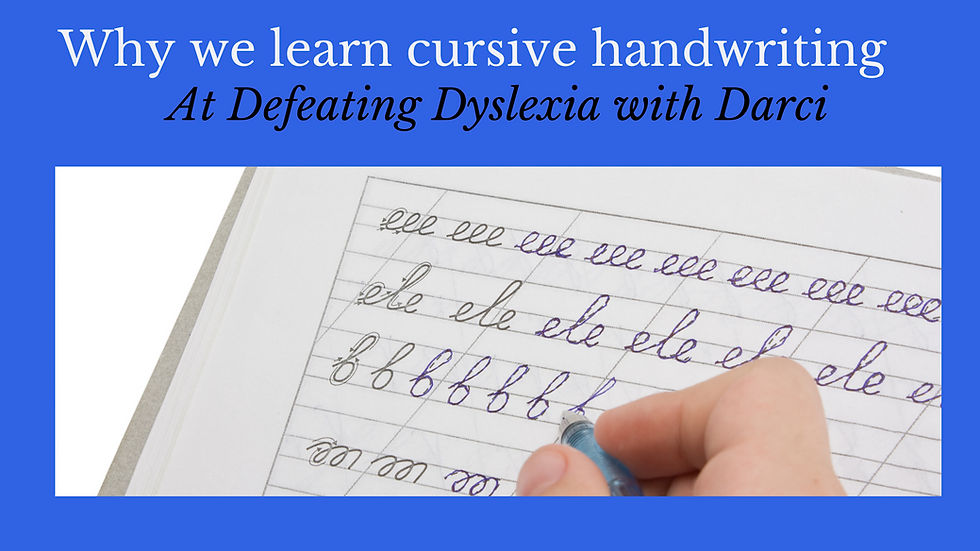Why we learn cursive handwriting at Defeating Dyslexia with Darci
- teacherdarcis
- Dec 31, 2020
- 3 min read
Updated: Dec 6, 2021

At Defeating Dyslexia with Darci all students learn cursive. It is part of what we do. Most kids think this is pretty cool just because it is a skill they will have that most kids their age do not. Knowing something others don’t is important to them especially considering that they have struggled in something that seems to come easy to everybody else. For some children who are artistic this is a great fun skill to learn that will enhance their artistic abilities also, but there are scientific reasons for learning cursive. It is not just beautiful handwriting that your grandparents used that is now unnecessary because we use keyboards. Let me explain why I use it as an important part of my tutoring for reading.
First, when our whole brain is working to learn and remember things it is much more efficient. When we read our brain will see the letters and words with our eyes, this is processed in the occipital lobe of the brain, which is in the back of the brain. Over in the temporal lobe, which is behind the ears, your brain will process the sound that letter makes and in the frontal lobe you will think about the word, what it means and how it relates to things you know. We also want to include the parietal lobe, which is where spatial perception is processed. This will give a complete multisensory experience. Every letter will have associated with it a name, a sound, a look, and a feel. How does that letter feel to say it? How does the mouth form the sound? And how does it feel to write it? There will be kinesthetic muscle memory associated with the letter. When the letter is practiced often enough it become automatic and easy to recall all of those things. The name, the sound, the look, the feel, and when those things are automatic it makes so many other things easier. When we practice them all together, they are more readily and permanently learned. This is what is referred to as multisensory learning. Studies show that “handwriting is important for the early recruitment in letter processing of brain regions known to underlie successful reading. Handwriting therefore may facilitate reading acquisition in young children”.[1]
Cursive solves some of the problems that many struggling readers have. All cursive lowercase letters start at the same place, so children do not need to remember how to start the letter. The letters b and d, and p and q are not formed the same and do not look like mirror images of each other, eliminating some confusion. Also, every letter in a word is connected and the pencil is only lifted from the page at the end of the word. This is helpful for those children who struggle with spacing in the correct place. Many times, this alone makes the handwriting much more readable.
Writing papers, whether it is a research paper, or a narrative story is one of the most difficult tasks any school child is asked to do. Some people assume that keyboarding will make this easier but the reality is that it is still really hard. Consider all that goes into writing- Generating ideas, gathering information, organizing. Keyboarding won’t help any of that and once you have the information and are ready to begin writing you must think about spelling, grammar, punctuation, and word choice and… It can be really overwhelming. It is so important that you do not also have to think about how letters are formed. Which one is the b vs the d…. When we practice handwriting and link the kinesthetic feel of making the letter with the sound and look of that letter it will mean that at least you will not have to struggle with the mechanics of writing when you are deciding on a topic for your paper.
Handwriting has been found to improve spelling and memory recall in several studies. When people actually write the words, as opposed to typing, they link not only the look and sound of the word but the physical feel of writing that word. This is why learning cursive and practicing it in connection with the rules of spelling that we work on help lock that rule in memory. It has also been shown that people who take notes during a college class with old fashioned paper and pen instead of on a keyboard remember those notes better. [2] No doubt the benefits of learning cursive will keep on giving for many years to come.
[1]James, Karin H. and Engelhardt, Laura; The effects of handwriting experience on functional brain development in pre-literate children [2] Cunningham, A. E., and Stanovich, K. E. (1990). Early spelling acquisition: writing beats the computer. J. Educ. Psychol. 82, 159–162. doi: 10.1037/0022-0663.82.1.159




Comments